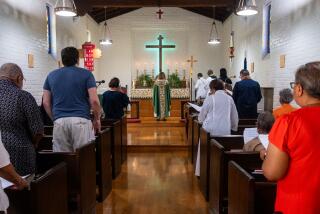Shoring up a national house of prayer
WASHINGTON — The earth shook under the nation’s church, snapping some of the 53 carillon bells’ cables and causing them to ring in forbidding disharmony.
Outside, cracks appeared on some of the wing-like flying buttresses supporting the 100-foot walls and intricate stone arches that mark the Washington National Cathedral as one of the world’s greatest Gothic churches.
Still the ground shuddered, coursing energy upward to the grimacing or mirthful gargoyles and the 152 pinnacles that rise like twirled candy above the sheet lead roof. The force, a raging river pressed into a narrow gully, became ever more concentrated as it flowed into the twin 234-foot west towers and the 301-foot central tower.
The tops of 50-ton pinnacles started swaying from north to south, then dancing like raindrops upon their pedestals. Crockets, finials and other ornaments, hand-chiseled by generations of mostly Italian carvers, started falling with booms that master stonemason Joe Alonso, outside on the grounds in his truck, thought were explosions.
Twenty-one years before, Alonso had put the Episcopal cathedral’s last stone in place, capping the nearly century-long effort to create a “house of prayer for all people,” the scene of events etched into the nation’s memory. When former President Reagan died in 2004, his state funeral there drew 4,000 people, including 36 kings, presidents and prime ministers.
The son of a stonemason who emigrated from Spain, Alonso’s lifelong work had been the cathedral, first building it, then maintaining it. Now, jumping out of his truck, he joined tourists and church staff who gaped at the building.
“I saw crowds looking up,” the 51-year-old said. “Then I saw the tower, the first three pinnacles, and I thought, wait a minute, is it gone?”
The fourth pinnacle was indeed gone. The job Alonso thought he had finished suddenly wasn’t.
*
The rare East Coast earthquake that hit at 1:51 p.m. on Aug. 23, 2011, shook more people than any other in U.S. history, from Georgia to the U.S.-Canada border.
“Everything was missing and twisted,” Alonso said. “My fear was, has the structure of the cathedral been compromised?”
A big fellow — 6 foot 5 — who went to a Catholic high school in Washington’s Virginia suburbs, he looks like the stone man that he is. But as he strides around its manicured grounds or leans out over its balconies — all the while pointing and exclaiming, “I built that arch!” or “I built that pinnacle!” — he emerges also as the philosopher in residence.
“This cathedral stands for a lot of things,” Alonso said recently, sitting on an overturned plastic pail in his masonry-dusted workshop littered with salvaged finials and lined with the tools of his trade.
“I’ve been around this cathedral for 27 years, and it affects people who visit many different ways,” he said. “Some come for the architecture, the craftsmanship, the artwork. Then there are those who walk in the door and fall on their knees and pray. This building, it touches people, on many different levels.”
On Sept. 29, 1990, Alonso and two other men guided the last stone, a 1,008-pound cross-shaped finial, into place on one of the west towers, as President George H.W. Bush and First Lady Barbara Bush looked on.
“It was 83 years from the day the first stone was laid,” with President Teddy Roosevelt supervising, Alonso said. “That, for me, was a powerful moment.
I was up there guiding that stone and I felt there were a lot of stonemason ghosts helping me do that.”
Now Alonso was afraid to know just how much work had been undone. He would have to climb the central tower, which rises above the center of the cross-shaped building, to find out.
“I thought, I don’t want to go up but I have to go up. As I climbed up the spiral staircase, I thought, am I going to see a big chunk of daylight through the walls?”
*
The National Cathedral was built in the old way, entirely by hand, with the exception of the cranes that lifted the pieces in place.
Two types of craftsmen and craftswomen built the exterior. Alonso is a stonemason, who wielded a trowel to put its pieces together. Alongside the masons worked the stone carvers, whose chisels sculpted the 112 gargoyles and 1,130 grotesques, the angels and the decorative crockets, or balls, the arches and the statues.
After high school Alonso learned the stone trade in Washington as an apprentice for four years in the Stone and Marble Masons Union, then went to work at the cathedral on the last big project, building the two west towers, which at that point were just barely above the roof line.
In fact, he married this sculpted hunk of stone even as he married his wife, Maureen, whom he first spied 27 years ago from the scaffolding high up on the South Tower as the young horticulturist was working the flower beds in the Bishop’s Garden below.
“I’m not a stone carver,” Alonso said with no trace of defensiveness. “I can’t carve your face in stone. But I can cut stone, shape stone. I was one of the masonry guys on the building with a trowel, building it.”
Like the schoolchildren who visit, he delights in the sense of humor displayed in some carvings. The cathedral’s message is religious, worshipful, but also full of jokes and secular references. Its most famous carving is a grotesque of Darth Vader, chosen in a schoolchildren’s competition. There is even “Flirting Stone Carver,” leaning lasciviously from the scaffolding while whistling at the girls below, and next to him, “Aghast Dean,” the priest in robes who is horrified by what Flirting Carver is up to.
Alonso’s favorite piece is a gargoyle of Medusa, the Greek monster with snakes instead of hair, who (appropriately for this setting) turned all who gazed on her to stone. “I put that in place,” he said proudly. “Who would have thought to put Medusa on a cathedral? That’s awesome.”
*
Alonso climbed the spiral staircase, and was relieved: He didn’t see daylight. “But when I got to the roof, it was just littered with stones from the pinnacles.” A two-ton pinnacle top had toppled, but it had fallen inward onto the tower. Had it gone the other way, it would have fallen 200 feet through the roof of the nave, the main body of the cathedral.
Looking down, he could see scaffolding on the north side of the nave where he and his two stone carvers, Andy Uhl and Sean Callahan, had planned to perform maintenance that afternoon until other chores got in the way. The area was littered with fist-sized chunks of stone.
Alonso says that despite his workplace, he is not overly religious. But at that moment, he thought, “There you go, the hand of God, the hand of whoever, was looking out for Andy, Sean and Joe.” And for their beloved cathedral. “I don’t think of God as Catholic or Episcopalian. But there is some higher being that liked this building who was looking out for us.”
Miraculously, no employees or visitors were hurt, even though at least 29 pinnacles were toppled, rotated on their base or otherwise damaged (one lodged in the roof), flying buttresses had cracked and separated from the walls, and small stones had rained down everywhere.
The cathedral was closed for nearly three months while workers assessed the damage and stabilized the structure. Although interior damage was minimal, netting shrouds the ceiling lest bits of mortar fall on worshipers. Chain-link fences keep visitors away from the damaged buttresses on the east end and parts of the nave. It is estimated repairs will cost at least $20 million and last years.
Alonso, who navigates the hidden stairways and corridors with the intimate knowledge of a child playing in his attic, took some visitors up a stairwell secreted within a large pinnacle on the south transept, the part of the cathedral that forms the arms of the cross.
There, on a scaffolding with a perilous view of the Potomac River, he pointed to what he says may be the biggest challenge of the reconstruction: a 20-ton pinnacle, rotated on its base, that is resting for the moment on a series of jacks and pipes.
“It’s like a giant hand took the top of this pinnacle and spun it,” Alonso said in wonder.
The pinnacle, and eight on the central tower, must be dismantled stone by stone and put back together again. At the central tower, the job requires a giant crane and 70 tons of steel scaffolding, already in place.
But one thing Alonso won’t need to repair will be the last finial he placed with great ceremony in 1990. It held steady.
Alonso, who was 24 when he came to work at the cathedral, now has knees that ache and betray the hint of a limp from too many days working on them instead of his feet.
“If I retire at 70, then I have 19 years to fix this place if my knees hold up,” Alonso said. “If they don’t, I’ll be up here in a walker.”
More to Read
Start your day right
Sign up for Essential California for news, features and recommendations from the L.A. Times and beyond in your inbox six days a week.
You may occasionally receive promotional content from the Los Angeles Times.







